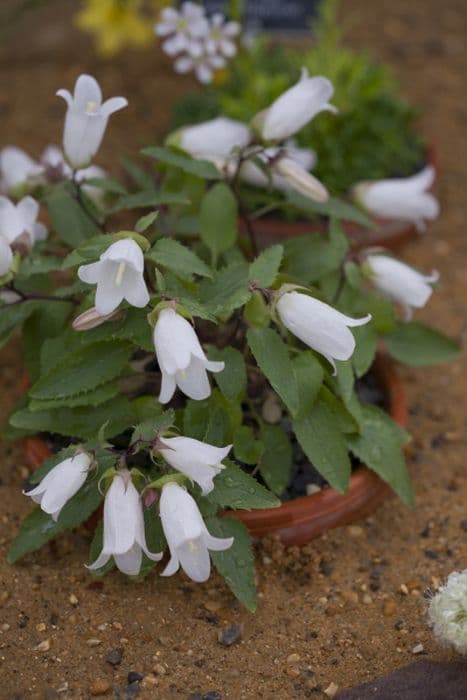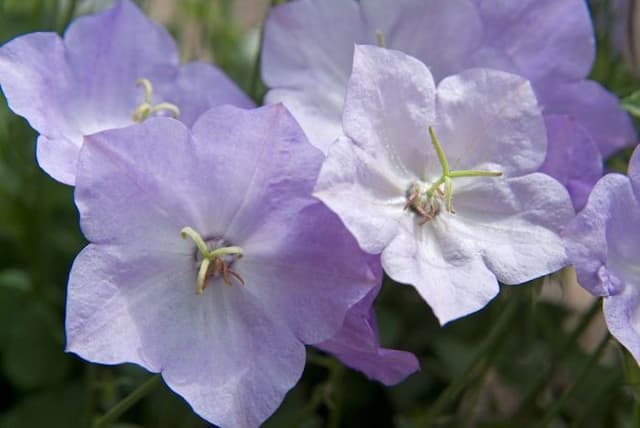Fairy Bellflower Campanula × pulloides hort. 'G.f. Wilson'

ABOUT
The plant commonly known as 'G.f. Wilson' is a charming and attractive garden plant that features a mounding habit with lush, green foliage. The leaves are typically shaped with a gentle roundness and may have a slight tooth-like texture at their edges. During its blooming period, this plant is adorned with an abundance of bell-shaped flowers that are a distinctive feature of its appearance. These blossoms are commonly known to come in shades of beautiful violet blue. The blooms gracefully hang or nod, giving them a whimsical and soft appearance that is quite eye-catching. The petals slightly overlap, with lighter coloration at the margins and a more intense hue in the center, which often accentuates their bell-like shape. The vivid and bright tone of the flowers contrasts nicely against the green foliage, making 'G.f. Wilson' an appealing choice for gardeners looking to add a pop of color to their landscape. The overall aesthetic of the plant is one that exudes a certain cottage-garden charm, making it a beloved addition to many gardens.
About this plant
 Names
NamesFamily
Campanulaceae
Synonyms
Fairbells, G.F. Wilson Bellflower
Common names
Campanula × pulloides hort. 'G.f. Wilson'.
 Toxicity
ToxicityTo humans
The Campanula × pulloides hort. 'G.f. Wilson', more commonly referred to as Bellflower, typically is not toxic to humans. Bellflowers are generally considered safe and there are no well-documented cases of toxicity from its ingestion. However, as with any plant, individual allergies or sensitivities can exist, and ingesting plant material may cause mild gastrointestinal discomfort for some people. It is always advisable to refrain from eating plants that are not specifically grown for consumption to avoid potential adverse reactions.
To pets
The Campanula × pulloides hort. 'G.f. Wilson', commonly known as Bellflower, is generally not considered toxic to pets. There is no significant evidence to suggest that Bellflowers pose a poisoning risk to dogs, cats, or other domestic animals. However, ingestion of any plant material can potentially cause mild gastrointestinal upset in pets, such as vomiting or diarrhea, especially if consumed in large quantities or if the animal has a sensitive stomach. It is always a good practice to monitor your pets and prevent them from eating ornamental plants to avoid any potential health issues.
 Characteristics
CharacteristicsLife cycle
Perennials
Foliage type
Deciduous
Color of leaves
Green
Flower color
Blue
Height
1 foot (30 cm)
Spread
1 foot (30 cm)
Plant type
Herb
Hardiness zones
5
Native area
Hybrid
Benefits
 General Benefits
General Benefits- Attracts Pollinators: Provides a valuable nectar source for bees, butterflies, and other beneficial insects.
- Aesthetic Appeal: Adds visual interest to gardens with its bell-shaped flowers and vibrant blue-violet hues.
- Low Maintenance: Typically easy to care for, requiring minimal attention once established in appropriate conditions.
- Ground Cover: Dense growth habit can help suppress weeds and cover bare spots in the garden.
- Drought Tolerant: Once established, it has good drought resistance, reducing the need for frequent watering.
- Cold Hardy: Capable of withstanding cooler temperatures, making it suitable for a variety of climates.
- Long Blooming: Provides a long flowering season, from late spring to early summer, offering sustained beauty.
- Wildlife Friendly: Can provide habitat and resources for small garden wildlife.
- Edging Plant: Works well for borders and edges in gardens due to its compact growth habit.
- Rock Gardens: Ideal for rock and alpine gardens due to its size and adaptability to well-drained soil conditions.
 Medical Properties
Medical PropertiesThis plant is not used for medical purposes.
 Air-purifying Qualities
Air-purifying QualitiesThis plant is not specifically known for air purifying qualities.
 Other Uses
Other Uses- As a natural dye: The flowers of bellflowers can be used to create a gentle blue or violet dye for fabrics or paper.
- In crafting: Dried bellflower blooms can be incorporated into potpourris, sachets, or decorative crafts such as wreaths.
- For culinary decoration: Edible varieties of bellflowers can be used to adorn cakes and pastries, adding a touch of floral beauty to desserts.
- In eco-printing: Leaves and flowers can be used in eco-printing techniques to transfer their shapes and colors onto paper or fabric.
- As a teaching tool: Bellflowers can be used in educational settings such as schools or botanical workshops to illustrate plant biology and horticulture.
- In photography: Because of their striking appearance, bellflowers make an attractive subject for botanical and macro photography.
- As a frost indicator: Bellflowers can serve as a natural indicator of the first frost when observed in the garden, signaling the end of the growing season.
- In companion planting: Bellflowers can be planted alongside vegetables and other garden plants in an attempt to attract pollinators.
- For natural fencing: Grown in dense clusters, bellflowers can be used to create natural, low-growing borders or fences that require minimal maintenance.
- In wedding bouquets: Due to their delicate form and variety of colors, bellflowers can be used in bridal bouquets and floral arrangements for special occasions.
Interesting Facts
 Feng Shui
Feng ShuiThe Canterbury Bells is not used in Feng Shui practice.
 Zodiac Sign Compitability
Zodiac Sign CompitabilityThe Canterbury Bells is not used in astrology practice.
 Plant Symbolism
Plant Symbolism- Gratitude: Campanula, commonly known as Bellflower, is often associated with gratitude. This could be due to its bell-shaped flowers that seem to be generously filled with beauty and grace, suggesting the giving nature of the plant.
- Constancy and Perseverance: The Bellflower's ability to grow in a variety of conditions and its long-lasting bloom period are suggestive of consistency and the determination to persist in the face of challenges.
- Humility: With its heads often bowed in a natural, humble posture, Campanula may symbolize humility.
- Unwavering Love: The endurance of the Bellflower through various seasons and conditions might also symbolize unwavering or everlasting love.
 Water
WaterThe Fairy Bellflower should be watered regularly, ensuring that the soil remains moist but not waterlogged. During the growing season, typically from spring to early autumn, watering once or twice a week should suffice, depending on weather conditions. When temperatures are warmer, or if the plant is in a particularly sunny spot, more frequent watering may be necessary. During the winter months, reduce watering to prevent root rot, supplying enough to prevent the soil from drying out completely, approximately every two weeks. The amount of water needed will vary with the size of the plant and the environmental conditions, but starting with half a gallon per watering session is a good baseline.
 Light
LightFairy Bellflowers perform best in partial shade, where they receive bright but indirect light. They can also tolerate full sun, especially if the climate is cooler, but in hotter regions, protection from the intense afternoon sun is essential. A spot that provides morning sunlight with afternoon shade would be ideal for this plant ensuring it gets sufficient daylight without being subjected to harsh, direct sunlight during the hottest part of the day.
 Temperature
TemperatureFairy Bellflowers thrive in moderate temperatures and are suited for USDA hardiness zones 4 through 8. They can withstand minimum temperatures down to around -30 degrees Fahrenheit and are quite cold hardy. However, they prefer the growing season to have temperatures that range between 60 to 75 degrees Fahrenheit. Protecting the plants from extreme heat or cold will ensure healthy growth.
 Pruning
PruningPruning Fairy Bellflowers is important to remove spent flowers and encourage a second bloom. Deadheading the wilting flowers prevents the plant from putting energy into seed production and maintains an attractive appearance. Cut back the stems after flowering has finished, usually in late summer or early autumn, to promote healthy growth for the next season. Pruning can also be done to shape the plant and keep it compact.
 Cleaning
CleaningAs needed
 Soil
SoilFor the Fairies Thimbles, a well-draining soil mix is crucial, composed of equal parts loam, peat, and sharp sand to promote drainage. The best pH range for this mix is slightly alkaline to neutral, around pH 7.0 to 7.5.
 Repotting
RepottingFairies Thimbles should be repotted every two to three years to refresh the soil and allow for growth. It's best to repot during the spring when the plant is emerging from dormancy.
 Humidity & Misting
Humidity & MistingFairies Thimbles prefer moderate humidity levels, but they are fairly adaptable. They can thrive in average room humidity, provided the air is not too dry.
 Suitable locations
Suitable locationsIndoor
Place Fairies Thimbles in bright, indirect light indoors.
Outdoor
Plant Fairies Thimbles in partial shade and sheltered area outdoors.
Hardiness zone
5-9 USDA
 Life cycle
Life cycleCampanula × pulloides 'G.F. Wilson', commonly known as Fairy Bellflower, begins its life cycle with germination, which occurs when its seeds encounter favorable conditions of moisture and temperature, typically in spring. Seedlings emerge, establishing a root system and foliage through vegetative growth during the spring and summer. As a perennial, the Fairy Bellflower then enters a phase of flowering in late spring to early summer, producing bell-shaped lavender to violet flowers that attract pollinators. After pollination, the flowers develop into fruit, which are capsules containing seeds, completing the reproductive stage. In autumn, the above-ground parts of the plant may die back as it enters dormancy, conserving energy in its roots. With the return of favorable conditions in the following spring, the Fairy Bellflower regrows from its rootstock, repeating its life cycle.
 Propogation
PropogationPropogation time
Spring to early summer
Propogation: The Fairy Bellflower, scientifically named Campanula × pulloides hort. 'G.f. Wilson', is most commonly propagated by division. Division is best performed in the spring as new growth begins to appear. This process involves gently separating the plant’s root ball into smaller sections, each with an adequate amount of roots and shoots. It's important to ensure each division has a strong set of roots to support new growth. Once divided, the sections can be replanted into well-draining soil, maintaining regular moisture until the newly planted divisions are well-established. This method of propagation allows gardeners to create new plants that are genetically identical to the parent, preserving the characteristics of the 'G.f. Wilson' variety.









